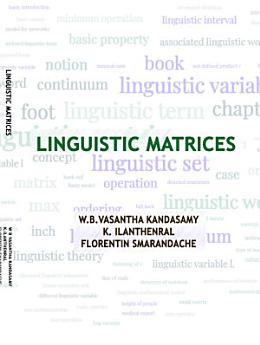Linguistic Matrices
W. B. Vasantha Kandasamy · Ilanthenral K. · Florentin Smarandache
অক্টো ২০২২ · Infinite Study
ইবুক
190
পৃষ্ঠা
family_home
যোগ্য
info
reportমূল্যাংকন আৰু পৰ্যালোচনা সত্যাপন কৰা হোৱা নাই অধিক জানক
এই ইবুকখনৰ বিষয়ে
In this book, the authors introduce the linguistic set associated with a linguistic variable and the structure of matrices, which they define as linguistic matrices. The authors build linguistic matrices only for those linguistic variables which yield a linguistic continuum or an ordered linguistic set. This book is organised into three chapters. The first chapter is introductory, in which we introduce all the basic concepts of linguistic variables and the associated linguistic set to make this book self-contained. Chapter two introduces linguistic matrices and develops basic properties associated with them, like types of matrices, transpose of matrices and diagonal matrices. Most of the properties enjoyed by real or complex matrices are satisfied by these linguistic matrices. Chapter three deals with operations on the linguistic matrices.
এই ইবুকখনক মূল্যাংকন কৰক
আমাক আপোনাৰ মতামত জনাওক।
পঢ়াৰ নির্দেশাৱলী
স্মাৰ্টফ’ন আৰু টেবলেট
Android আৰু iPad/iPhoneৰ বাবে Google Play Books এপটো ইনষ্টল কৰক। ই স্বয়ংক্রিয়ভাৱে আপোনাৰ একাউণ্টৰ সৈতে ছিংক হয় আৰু আপুনি য'তে নাথাকক ত'তেই কোনো অডিঅ'বুক অনলাইন বা অফলাইনত শুনিবলৈ সুবিধা দিয়ে।
লেপটপ আৰু কম্পিউটাৰ
আপুনি কম্পিউটাৰৰ ৱেব ব্রাউজাৰ ব্যৱহাৰ কৰি Google Playত কিনা অডিঅ'বুকসমূহ শুনিব পাৰে।
ই-ৰীডাৰ আৰু অন্য ডিভাইচ
Kobo eReadersৰ দৰে ই-চিয়াঁহীৰ ডিভাইচসমূহত পঢ়িবলৈ, আপুনি এটা ফাইল ডাউনল’ড কৰি সেইটো আপোনাৰ ডিভাইচলৈ স্থানান্তৰণ কৰিব লাগিব। সমৰ্থিত ই-ৰিডাৰলৈ ফাইলটো কেনেকৈ স্থানান্তৰ কৰিব জানিবলৈ সহায় কেন্দ্ৰত থকা সবিশেষ নিৰ্দেশাৱলী চাওক।







